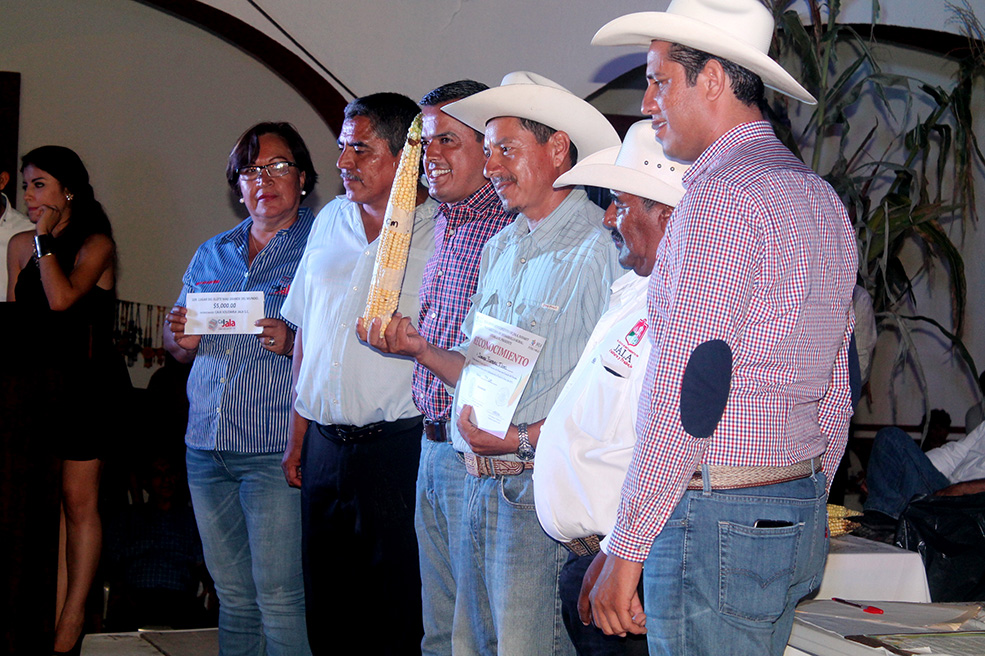
Photo: Victor Vidal/INIFAP
On 14 August 2015, I was one of the judges in the contest to find “The World’s Largest Maize Ear” held in Jala, Nayarit, Mexico. The contest is one of the most popular events during the week-long celebration in honor of the town’s patron saint. This was the third time I was a judge, and the contest has become an annual highlight for me in my role as one of the custodians of the world’s maize genetic diversity. The Jala landrace will always hold a special place in my heart, not just because of its size, which is impressive, but also because of the culture surrounding it and the dedication of the people who grow it.
I met my friend, Dr. Victor Vidal, INIFAP maize breeder and enthusiastic supporter of maize genetic resources, at the flagpole on the main street separating the twin towns of Jala and Jomulco. Our first stop was the stall of the family of Don José Antioco Elías Partida of Coapan, the winner of last year’s contest, and a winning contestant for many years. We learned that sadly, Don José had died earlier in the year. However, two of his sons, continuing the family tradition, entered the contest this year.
At 4:45 p.m., the contestants gathered in the auditorium of the town hall, and watched a video about Jala maize, created by Dr. J. Arahón Hernández Guzmán, a local “boy” who got his Ph.D. at Cornell, and is now a professor at the Colegio de Posgraduados in Puebla. He presented Victor and me with copies of his video. Afterwards, the “convocatoria” (list of contest regulations) was read out loud. There was a bit of discussion about the rule that the maize be grown under “natural conditions,” i.e., no irrigation.
We judges were called to the stage, introduced, and the convocatoria was read once again. We split up into three teams, and the contestants, three at a time, were called up to have their five ears of Jala maize shucked and measured. The largest ear was selected, and its length and the contestant’s number were written on pieces of masking tape that were stuck on the ear. The contestants’ names and the length of their largest ear were announced, and photos were taken. Most ears were 30+ cm long, only a few were 40+. The crowd definitely kept track, cheering loudly for their friends, and especially for the 40+ ears. The very first farmer who came to our table had the winning ear, at 44 cm. As the contest proceeded, there would be a murmur of disappointment when another farmer had an ear that was almost a winner.
Judging Team #2 in action, shucking and measuring Jala maize on stage, including Denise Costich (CIMMYT), and Victor Vidal (INIFAP) on the right. Photo: Victor Vidal/INIFAPOnce all the shucking and measuring are completed, there is always an interval while the data from the different teams are collated and the winning places are assigned. During this time, my friend Victor gave an explanation of why some of the ears did not produce kernels (the reason: lack of pollination). As it happened, one of the oldest contestants had brought in an ear that was 48 cm long, but none of the grain was filled, so it had to be disqualified. However, this showed that there is genetic potential for still larger ears. With the approval of the mayor of Jala, Victor proposed that another contest be held at harvest time, when the ears would be mature enough to be stored and eventually germinate. Having the contest at harvest time would allow for further selection and improvement of the Jala landrace; in addition, seed of the outstanding phenotypes could be stored in germplasm banks.
At the end of the contest, there was a moving ceremony in memory of the late Don José Elías, and his family came on stage to accept the tribute. Three generations of proud Jala maize growers stood before the crowd, the youngest held in the arms of his father, exemplifying a tradition that keeps maize landraces alive and well as an integral part of the culture and food security of Mexico and the world.
Three generations of the family of the late Don José Antioco Elías Partida, accepting an award recognizing Don José’s contributions. Photo: Denise Costich/CIMMYTContributions from Victor Vidal
 Nutrition, health and food security
Nutrition, health and food security 
